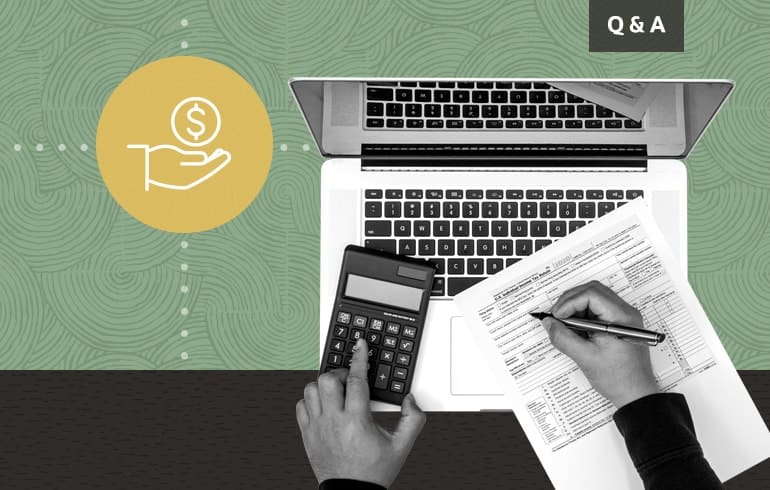In short:
- Entrepreneurs have a lot to think about. May we add to the list?
- Growing companies might not be thinking about being acquired or seeking a major funding infusion. But it can’t hurt to keep your options open.
- Those tax tricks that keep your on-paper income low? They may come back to bite you.
We’ve all seen Shark Tank smackdowns where founders walk in with valuations that have zero basis in reality. Don’t be that founder.
As you build your business, you’ll make a series of decisions that will affect the valuation that a lender, investor or acquirer deems reasonable for your company. In many cases, though, that’s far from top-of-mind when making choices.
Dave Bookbinder, a business valuation expert, best-selling author, speaker and podcaster, says that the number the sharks throw back at a funding-seeker might seem arbitrary, but there are solid methodologies in play. We spoke with Bookbinder to find out how young companies can make smart moves early on and build solid valuations as they grow.
Brainyard: A lot clearly goes into estimating valuation – too much to fully cover here (see the resources box for recommended reading). What are the top few factors you look at first?
Dave Bookbinder: “Beauty is in the eye of the beholder,” and similarly, valuation is a relative concept in that any business is worth what someone is willing to pay for it. That said, there are several key considerations in a valuation analysis.
What you’ve done in the past matters. Historic financial performance, both growth and profitability, are key. All things being equal, a faster growing and/or more profitable company will be worth more than its slower growing/less profitable counterparts. So when deciding whether to launch a new product, for example, make sure expected unit margins are solid and that you can keep them that way and still increase your market share.
The magic of the multiple. One valuation method relies on trading multiples of a peer group or transaction multiples from benchmark transactions. While every dollar earned can be thought of in the context of it being worth X times that amount, this method generally reflects past performance and doesn’t always tell the whole story.
Vision matters. Valuation is really a forward-looking exercise, where the present value of future expected cash flows determines the value of the business in today’s dollars. Historic growth and profitability don’t matter if the future outlook for the company or its industry isn’t as rosy. Conversely, if your company is about to achieve a breakthrough that isn’t reflected by past performance, you need to let the funder know.
It’s all about risk and reward. Investors and buyers expect to be compensated for their investment risk. Those future expected cash flows are discounted at a risk rate that reflects the risk of the business not achieving those future cash flows. Anything that can be done to de-risk the business will increase its valuation, because that’s the way the math works: The lower the risk rate, the higher the valuation.
Valuations aren’t done on the back of an envelope. Despite how it looks on TV, there are a host of considerations baked into a proper valuation analysis, and it’s wise to use several methodologies to ensure that the analysis hangs together and can withstand scrutiny. Guessing on a multiple of EBITDA may be easy, but it won’t be accurate.
BY: Have you worked with companies that, from the outset, built themselves as acquisition targets, with an eye to getting the highest valuation? For example, is that a consideration in what capital assets they acquire, or executive hires?
DB: From my experience, few businesses are run as a grab bag of assets per se. If there’s any thinking about an exit — and that’s not always the case — they know it’s about showing profitability.
I have seen founders make a mistake by trying to structure their businesses to minimize the payment of taxes. When they’re successful at that, net income might be zero or even negative. Then perhaps they start to think about M&A and contemplate applying a multiple to zero or negative net income. That’s usually when they get religion.
Decisions should be framed in light of demonstrating cash flow positivity, so that when you’re going to market, you’re not wasting your time explaining all those normalizing adjustments based on tax acrobatics. For young companies, it’s about handing an investor or a buyer a financial statement that shows positive cash flow. It’s much less about real assets at that point — especially now with how things have changed in terms of real estate.
BY: OK, so besides tax shenanigans, what are some common mistakes you see young companies make that come back to bite them when they look to get a strong valuation?
DB: Young companies have enough to deal with just to remain competitive and may not worry about getting their accounting “quite right” early on. When they’ve grown to the point where they now want to issue stock options or attract smart money, they often face financial restatements because of being sloppy earlier.
Yes, they’re typically strapped for cash and can’t afford certain “discretionary” investments. But bringing on a controller or VP of finance, or fractional CFO, to help with financial stewardship allows founders to do what they do best.

Do I Need a CFO? The Entrepreneur’s Guide to Growing Your Finance Team: Here’s a roadmap to align the makeup of your team with your company’s stage — and why an outsourced CFO might be your best bet. LEARN MORE
Startups also get into trouble when they don’t surround themselves with solid advisers. For example, a well-functioning advisory board can provide a breadth and depth of experience as well as a network of contacts that is priceless.
Another mistake I see is founders who either try to hire the lowest-cost professionals — think accountants, attorneys, IT providers … valuation consultants — or just go it alone with Google. They think they’re saving a few bucks, but in the end, bad advice could cost the company multiples of perceived savings. You get what you pay for, and you probably wouldn’t just accept the lowest bid from a contractor or look for the lowest-priced doctor. The same should be true with any professional service. Don’t make decisions solely based on price.
BY: What intangibles affect valuation?
DB: The majority of a company’s value can be attributed to intangible assets. Things like trademarks, patents and other intellectual property assets will get the most attention. But I believe that the most valuable intangible asset that a company has is one that doesn’t even appear on a financial statement: its people. I wrote a book on this topic called The New ROI: Return on Individuals.
Pro Tip: There are plenty of tools to assess organizational culture and employee satisfaction, from the relatively straightforward employee Net Promoter Score to the in-depth OCAI. PEs love data, so consider being proactive if you’re seeking funding. Here are more things PEs look for.
Treating your people like investments rather than expenses will create loyalty, improve engagement, reduce turnover, drive discretionary effort and increase profitability. It’s all connected and will increase the value of the business. That’s why I say “The value of a business is a function of how well the financial capital and the intellectual capital are managed by the human capital. You’d better get the human capital part right!”
That quote has been shared around the world, by the way!
BY: It’s very true. So how has the pandemic affected how you see valuations being calculated in five, even 10 years?
DB: While the pandemic has created a great deal of turbulence in the economy, I think that looking out five to 10 years from now, the pandemic will, hopefully, be a distant memory and not be a factor in valuation analyses.
I do think that business continuity and crisis response plans will consider pandemics and other previously “unlikely” sources of interruptions and, indirectly related to valuations, companies should be regularly testing those plans to reduce the impact of the next disruption.
My biggest concern is for the small businesses that have been impacted by the pandemic and may never be able to recover. If you’ve ever asked a local business to support your kids’ sports teams or school programs, here’s your chance to return the favor. Those local businesses need your support now.
BY: That’s also true. OK, so best practices that apply to a cross-section of business types. What are you advising entrepreneurs and founders now?
DB: This advice holds true in any industry and any environment. In a word: Plan.
Plan for contingencies, plan for management depth and succession and plan for the endgame. An exit is more than a transactional event – it’s a process that takes place over years leading up to the event. Sometimes exits are unplanned, due to death of a partner, illness or perhaps economic circumstances. For these reasons, it is imperative to always have “your house in order” just in case.
We talked about the present value of future cash flows as a valuation technique, so having an idea about those future cash flows is important. I realize that it’s not easy to look three to five years into the future, but the discipline of long-term planning will help to identify risks around achieving revenue growth, or needs for capital or staffing. Make it a living document – not something that only gets reviewed on an annual basis.
Build the right team like you would a baseball roster. A team with a diversity of skills, experience and strengths will exceed the sum of its parts. Then empower them to do what you hired them to do. Make building a great corporate culture a strategic imperative. It will pay huge dividends.
Let go of any ego around being the “key person.” Bring the team into discussions with the idea that if you, or any of them, are incapacitated for a period of time, the business will be able to continue. When we talk about de-risking the business, it should be pointed out that investors do consider something called “key man risk” in their valuation assessments. Ask yourself the age-old question: “Can the business survive if I get hit by a bus tomorrow?” If the answer is “no,” then you know what you need to do.

About our expert: Dave Bookbinder, ASA, CEIV is senior director with accounting advisory firm CFGI, a valuation expert and a best-selling author. Dave has conducted thousands of valuations of the securities and intellectual property assets of public and private companies across all industries. Dave also hosts an internet TV show and podcast called Behind The Numbers and writes about business and leadership at Thrive Global, CFO University and TLNT.com.
He holds a bachelor’s degree in Economics from Temple University and a master’s degree in Finance from Drexel University. Follow him at @dbookbinder on Twitter or @DavidLBookbinder on Facebook:

For more helpful information from the Brainyard and our friends at Grow Wire and the NetSuite Blog, visit the Business Now Resource Guide.









